Strategic Supply Chain Management Analysis: Indian Manufacturing Firms
VerifiedAdded on 2023/01/17
|42
|13593
|68
Report
AI Summary
This report delves into the strategic supply chain management practices within the Indian manufacturing sector, with a specific focus on the electrical industry. The research highlights the importance of effective supply chain management in addressing challenges such as cost control, environmental concerns, and increasing demand. The study employs various research methods to gather data and identifies lean and green supply chain management as crucial strategies for overcoming these obstacles. The report examines the challenges faced by the Indian electrical industry, including complexity, consistency, and external forces. It recommends the adoption of lean and green supply chain practices to eliminate waste, reduce costs, and minimize environmental impact. The analysis emphasizes the significance of strategic supply chain management in achieving competitive advantage and improving the overall performance of Indian manufacturing firms.
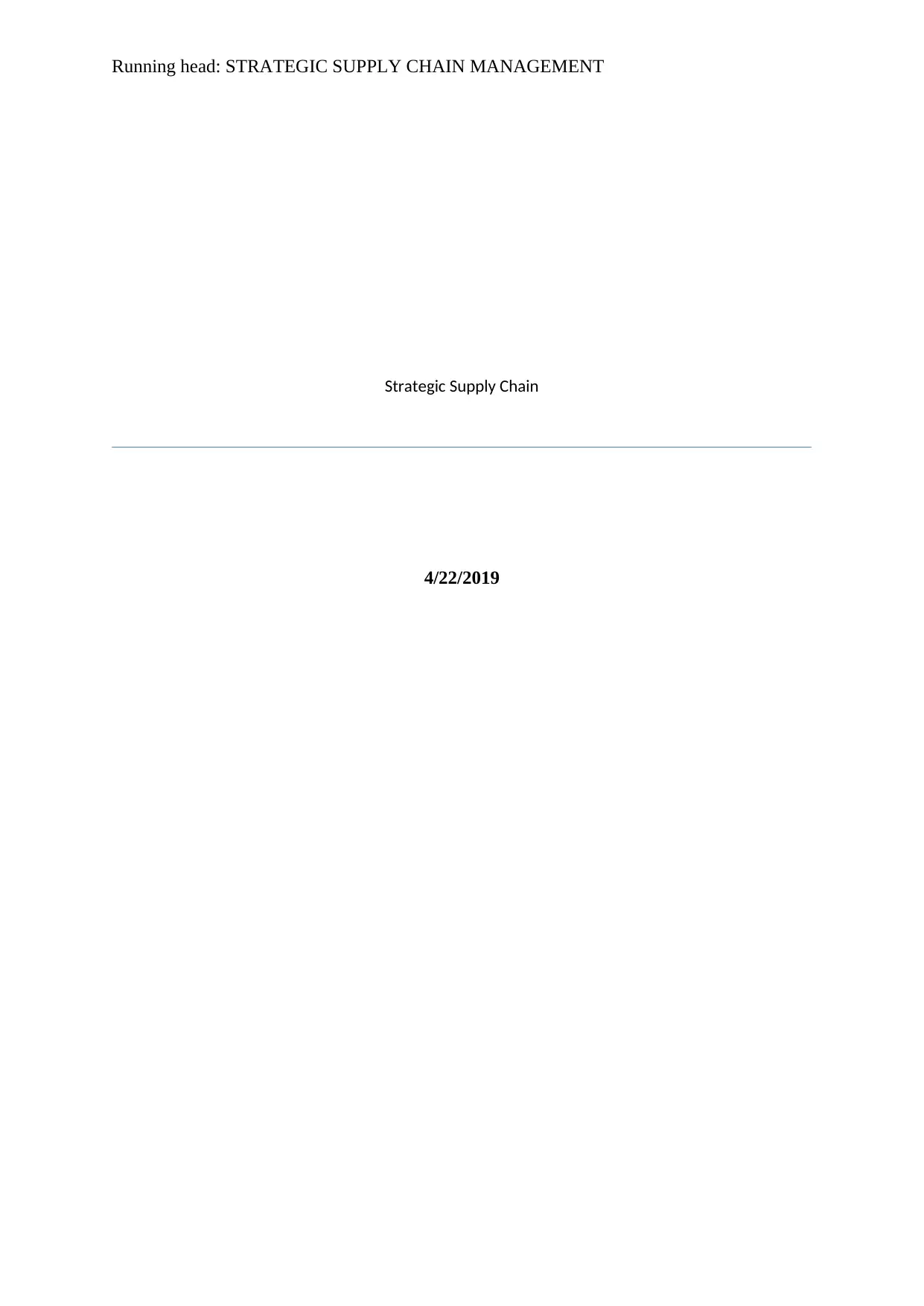
Running head: STRATEGIC SUPPLY CHAIN MANAGEMENT
Strategic Supply Chain
4/22/2019
Strategic Supply Chain
4/22/2019
Paraphrase This Document
Need a fresh take? Get an instant paraphrase of this document with our AI Paraphraser
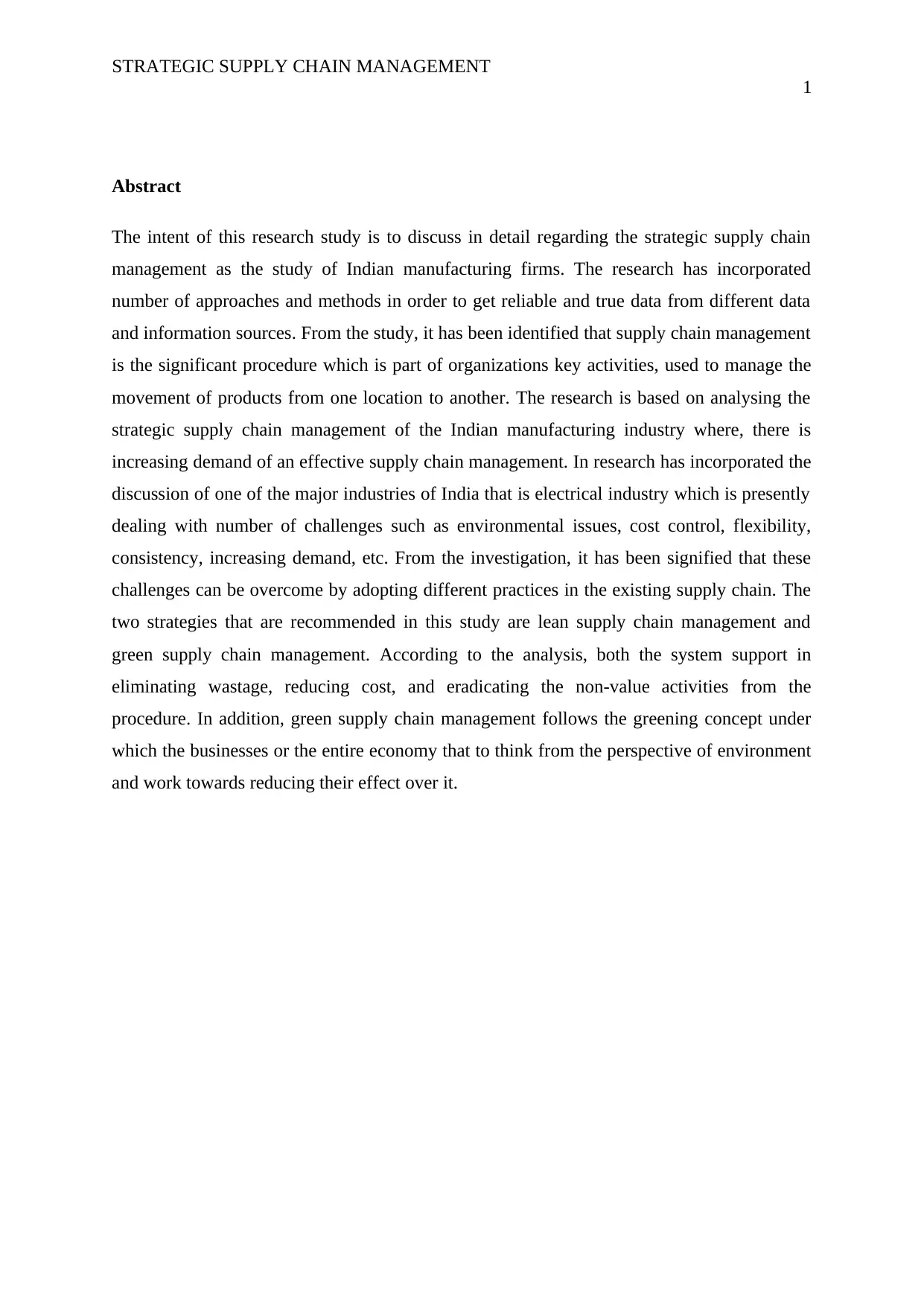
STRATEGIC SUPPLY CHAIN MANAGEMENT
1
Abstract
The intent of this research study is to discuss in detail regarding the strategic supply chain
management as the study of Indian manufacturing firms. The research has incorporated
number of approaches and methods in order to get reliable and true data from different data
and information sources. From the study, it has been identified that supply chain management
is the significant procedure which is part of organizations key activities, used to manage the
movement of products from one location to another. The research is based on analysing the
strategic supply chain management of the Indian manufacturing industry where, there is
increasing demand of an effective supply chain management. In research has incorporated the
discussion of one of the major industries of India that is electrical industry which is presently
dealing with number of challenges such as environmental issues, cost control, flexibility,
consistency, increasing demand, etc. From the investigation, it has been signified that these
challenges can be overcome by adopting different practices in the existing supply chain. The
two strategies that are recommended in this study are lean supply chain management and
green supply chain management. According to the analysis, both the system support in
eliminating wastage, reducing cost, and eradicating the non-value activities from the
procedure. In addition, green supply chain management follows the greening concept under
which the businesses or the entire economy that to think from the perspective of environment
and work towards reducing their effect over it.
1
Abstract
The intent of this research study is to discuss in detail regarding the strategic supply chain
management as the study of Indian manufacturing firms. The research has incorporated
number of approaches and methods in order to get reliable and true data from different data
and information sources. From the study, it has been identified that supply chain management
is the significant procedure which is part of organizations key activities, used to manage the
movement of products from one location to another. The research is based on analysing the
strategic supply chain management of the Indian manufacturing industry where, there is
increasing demand of an effective supply chain management. In research has incorporated the
discussion of one of the major industries of India that is electrical industry which is presently
dealing with number of challenges such as environmental issues, cost control, flexibility,
consistency, increasing demand, etc. From the investigation, it has been signified that these
challenges can be overcome by adopting different practices in the existing supply chain. The
two strategies that are recommended in this study are lean supply chain management and
green supply chain management. According to the analysis, both the system support in
eliminating wastage, reducing cost, and eradicating the non-value activities from the
procedure. In addition, green supply chain management follows the greening concept under
which the businesses or the entire economy that to think from the perspective of environment
and work towards reducing their effect over it.
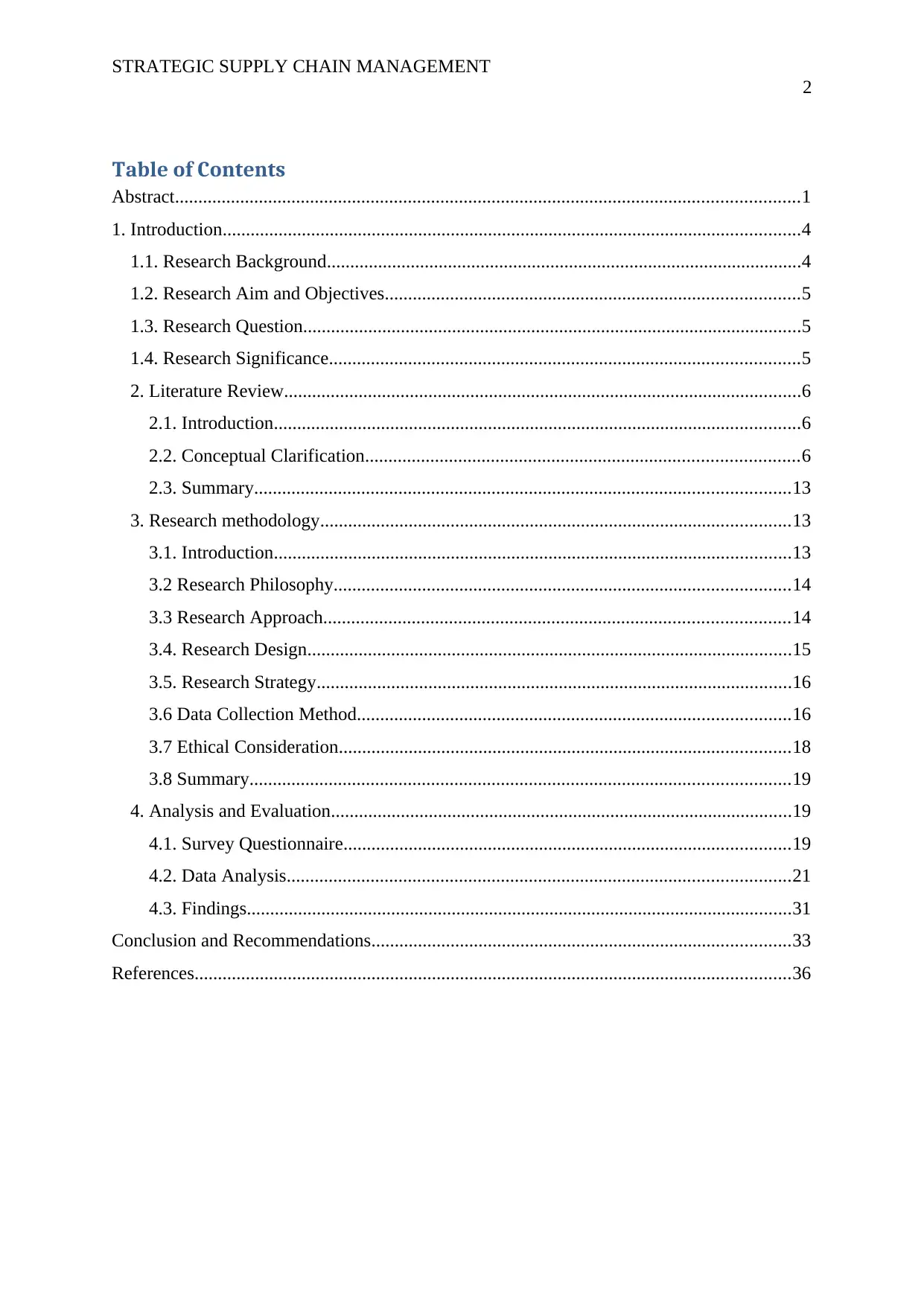
STRATEGIC SUPPLY CHAIN MANAGEMENT
2
Table of Contents
Abstract......................................................................................................................................1
1. Introduction............................................................................................................................4
1.1. Research Background......................................................................................................4
1.2. Research Aim and Objectives.........................................................................................5
1.3. Research Question...........................................................................................................5
1.4. Research Significance.....................................................................................................5
2. Literature Review...............................................................................................................6
2.1. Introduction.................................................................................................................6
2.2. Conceptual Clarification.............................................................................................6
2.3. Summary...................................................................................................................13
3. Research methodology.....................................................................................................13
3.1. Introduction...............................................................................................................13
3.2 Research Philosophy..................................................................................................14
3.3 Research Approach....................................................................................................14
3.4. Research Design........................................................................................................15
3.5. Research Strategy......................................................................................................16
3.6 Data Collection Method.............................................................................................16
3.7 Ethical Consideration.................................................................................................18
3.8 Summary....................................................................................................................19
4. Analysis and Evaluation...................................................................................................19
4.1. Survey Questionnaire................................................................................................19
4.2. Data Analysis............................................................................................................21
4.3. Findings.....................................................................................................................31
Conclusion and Recommendations..........................................................................................33
References................................................................................................................................36
2
Table of Contents
Abstract......................................................................................................................................1
1. Introduction............................................................................................................................4
1.1. Research Background......................................................................................................4
1.2. Research Aim and Objectives.........................................................................................5
1.3. Research Question...........................................................................................................5
1.4. Research Significance.....................................................................................................5
2. Literature Review...............................................................................................................6
2.1. Introduction.................................................................................................................6
2.2. Conceptual Clarification.............................................................................................6
2.3. Summary...................................................................................................................13
3. Research methodology.....................................................................................................13
3.1. Introduction...............................................................................................................13
3.2 Research Philosophy..................................................................................................14
3.3 Research Approach....................................................................................................14
3.4. Research Design........................................................................................................15
3.5. Research Strategy......................................................................................................16
3.6 Data Collection Method.............................................................................................16
3.7 Ethical Consideration.................................................................................................18
3.8 Summary....................................................................................................................19
4. Analysis and Evaluation...................................................................................................19
4.1. Survey Questionnaire................................................................................................19
4.2. Data Analysis............................................................................................................21
4.3. Findings.....................................................................................................................31
Conclusion and Recommendations..........................................................................................33
References................................................................................................................................36
⊘ This is a preview!⊘
Do you want full access?
Subscribe today to unlock all pages.

Trusted by 1+ million students worldwide

STRATEGIC SUPPLY CHAIN MANAGEMENT
3
3
Paraphrase This Document
Need a fresh take? Get an instant paraphrase of this document with our AI Paraphraser
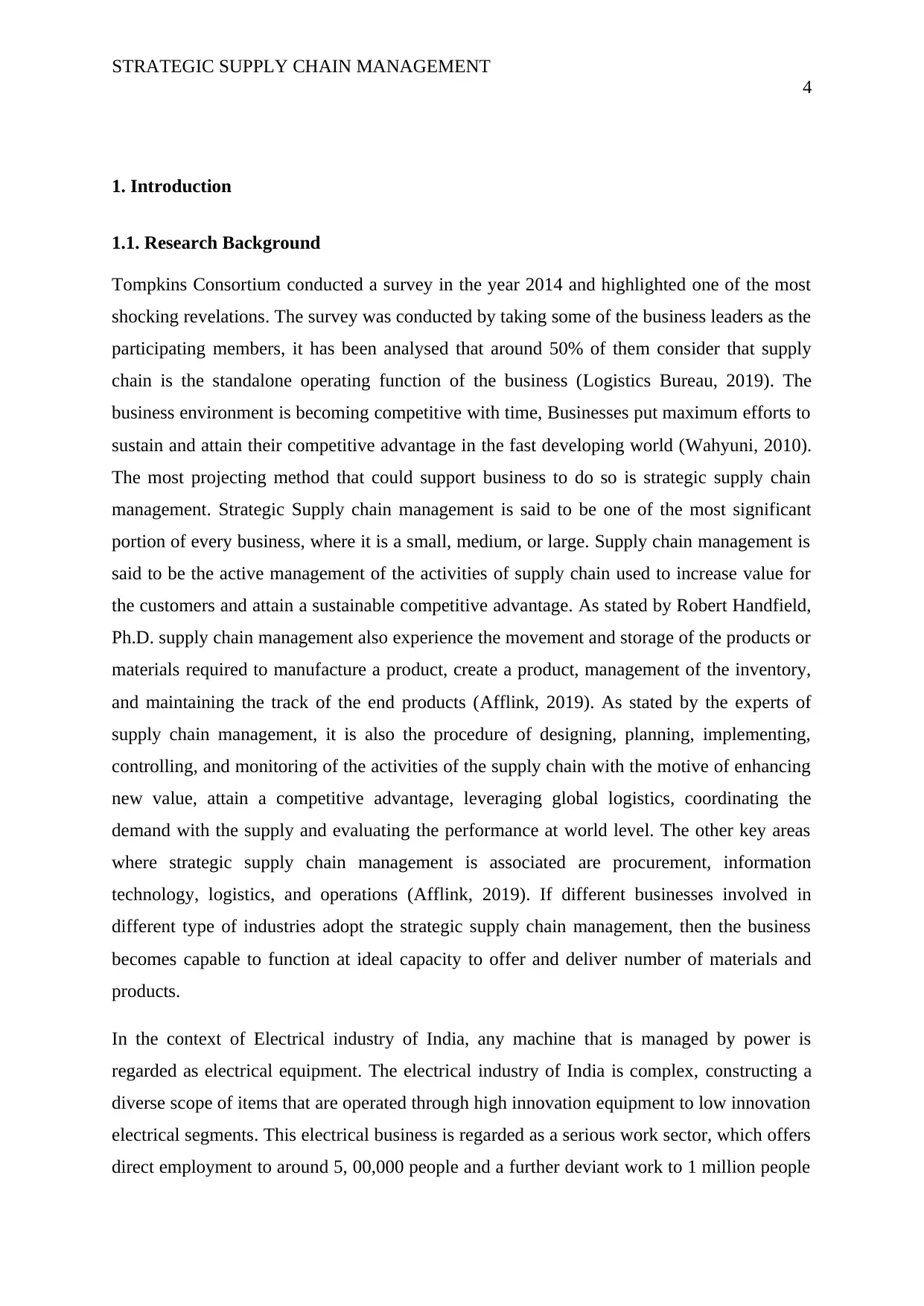
STRATEGIC SUPPLY CHAIN MANAGEMENT
4
1. Introduction
1.1. Research Background
Tompkins Consortium conducted a survey in the year 2014 and highlighted one of the most
shocking revelations. The survey was conducted by taking some of the business leaders as the
participating members, it has been analysed that around 50% of them consider that supply
chain is the standalone operating function of the business (Logistics Bureau, 2019). The
business environment is becoming competitive with time, Businesses put maximum efforts to
sustain and attain their competitive advantage in the fast developing world (Wahyuni, 2010).
The most projecting method that could support business to do so is strategic supply chain
management. Strategic Supply chain management is said to be one of the most significant
portion of every business, where it is a small, medium, or large. Supply chain management is
said to be the active management of the activities of supply chain used to increase value for
the customers and attain a sustainable competitive advantage. As stated by Robert Handfield,
Ph.D. supply chain management also experience the movement and storage of the products or
materials required to manufacture a product, create a product, management of the inventory,
and maintaining the track of the end products (Afflink, 2019). As stated by the experts of
supply chain management, it is also the procedure of designing, planning, implementing,
controlling, and monitoring of the activities of the supply chain with the motive of enhancing
new value, attain a competitive advantage, leveraging global logistics, coordinating the
demand with the supply and evaluating the performance at world level. The other key areas
where strategic supply chain management is associated are procurement, information
technology, logistics, and operations (Afflink, 2019). If different businesses involved in
different type of industries adopt the strategic supply chain management, then the business
becomes capable to function at ideal capacity to offer and deliver number of materials and
products.
In the context of Electrical industry of India, any machine that is managed by power is
regarded as electrical equipment. The electrical industry of India is complex, constructing a
diverse scope of items that are operated through high innovation equipment to low innovation
electrical segments. This electrical business is regarded as a serious work sector, which offers
direct employment to around 5, 00,000 people and a further deviant work to 1 million people
4
1. Introduction
1.1. Research Background
Tompkins Consortium conducted a survey in the year 2014 and highlighted one of the most
shocking revelations. The survey was conducted by taking some of the business leaders as the
participating members, it has been analysed that around 50% of them consider that supply
chain is the standalone operating function of the business (Logistics Bureau, 2019). The
business environment is becoming competitive with time, Businesses put maximum efforts to
sustain and attain their competitive advantage in the fast developing world (Wahyuni, 2010).
The most projecting method that could support business to do so is strategic supply chain
management. Strategic Supply chain management is said to be one of the most significant
portion of every business, where it is a small, medium, or large. Supply chain management is
said to be the active management of the activities of supply chain used to increase value for
the customers and attain a sustainable competitive advantage. As stated by Robert Handfield,
Ph.D. supply chain management also experience the movement and storage of the products or
materials required to manufacture a product, create a product, management of the inventory,
and maintaining the track of the end products (Afflink, 2019). As stated by the experts of
supply chain management, it is also the procedure of designing, planning, implementing,
controlling, and monitoring of the activities of the supply chain with the motive of enhancing
new value, attain a competitive advantage, leveraging global logistics, coordinating the
demand with the supply and evaluating the performance at world level. The other key areas
where strategic supply chain management is associated are procurement, information
technology, logistics, and operations (Afflink, 2019). If different businesses involved in
different type of industries adopt the strategic supply chain management, then the business
becomes capable to function at ideal capacity to offer and deliver number of materials and
products.
In the context of Electrical industry of India, any machine that is managed by power is
regarded as electrical equipment. The electrical industry of India is complex, constructing a
diverse scope of items that are operated through high innovation equipment to low innovation
electrical segments. This electrical business is regarded as a serious work sector, which offers
direct employment to around 5, 00,000 people and a further deviant work to 1 million people
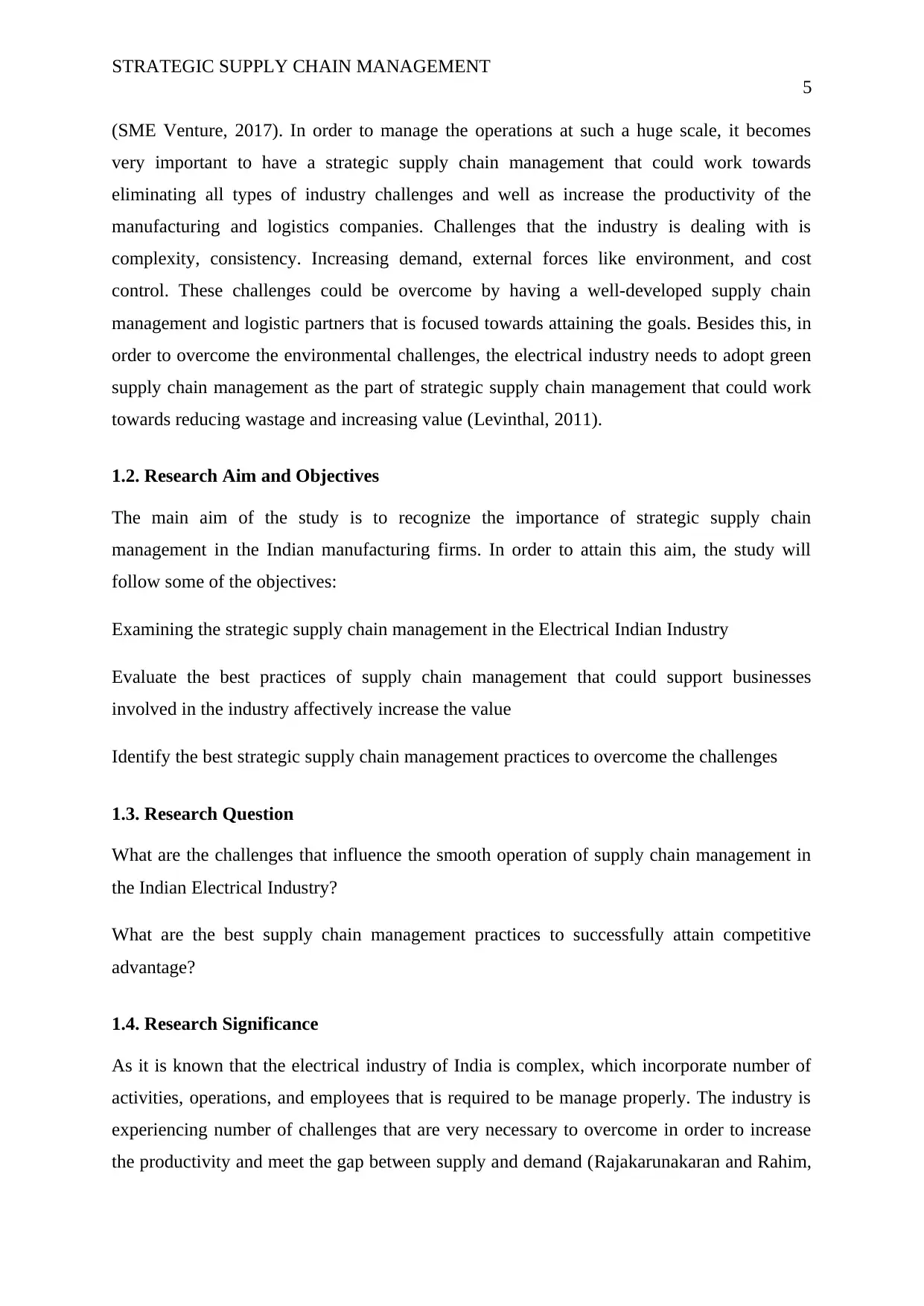
STRATEGIC SUPPLY CHAIN MANAGEMENT
5
(SME Venture, 2017). In order to manage the operations at such a huge scale, it becomes
very important to have a strategic supply chain management that could work towards
eliminating all types of industry challenges and well as increase the productivity of the
manufacturing and logistics companies. Challenges that the industry is dealing with is
complexity, consistency. Increasing demand, external forces like environment, and cost
control. These challenges could be overcome by having a well-developed supply chain
management and logistic partners that is focused towards attaining the goals. Besides this, in
order to overcome the environmental challenges, the electrical industry needs to adopt green
supply chain management as the part of strategic supply chain management that could work
towards reducing wastage and increasing value (Levinthal, 2011).
1.2. Research Aim and Objectives
The main aim of the study is to recognize the importance of strategic supply chain
management in the Indian manufacturing firms. In order to attain this aim, the study will
follow some of the objectives:
Examining the strategic supply chain management in the Electrical Indian Industry
Evaluate the best practices of supply chain management that could support businesses
involved in the industry affectively increase the value
Identify the best strategic supply chain management practices to overcome the challenges
1.3. Research Question
What are the challenges that influence the smooth operation of supply chain management in
the Indian Electrical Industry?
What are the best supply chain management practices to successfully attain competitive
advantage?
1.4. Research Significance
As it is known that the electrical industry of India is complex, which incorporate number of
activities, operations, and employees that is required to be manage properly. The industry is
experiencing number of challenges that are very necessary to overcome in order to increase
the productivity and meet the gap between supply and demand (Rajakarunakaran and Rahim,
5
(SME Venture, 2017). In order to manage the operations at such a huge scale, it becomes
very important to have a strategic supply chain management that could work towards
eliminating all types of industry challenges and well as increase the productivity of the
manufacturing and logistics companies. Challenges that the industry is dealing with is
complexity, consistency. Increasing demand, external forces like environment, and cost
control. These challenges could be overcome by having a well-developed supply chain
management and logistic partners that is focused towards attaining the goals. Besides this, in
order to overcome the environmental challenges, the electrical industry needs to adopt green
supply chain management as the part of strategic supply chain management that could work
towards reducing wastage and increasing value (Levinthal, 2011).
1.2. Research Aim and Objectives
The main aim of the study is to recognize the importance of strategic supply chain
management in the Indian manufacturing firms. In order to attain this aim, the study will
follow some of the objectives:
Examining the strategic supply chain management in the Electrical Indian Industry
Evaluate the best practices of supply chain management that could support businesses
involved in the industry affectively increase the value
Identify the best strategic supply chain management practices to overcome the challenges
1.3. Research Question
What are the challenges that influence the smooth operation of supply chain management in
the Indian Electrical Industry?
What are the best supply chain management practices to successfully attain competitive
advantage?
1.4. Research Significance
As it is known that the electrical industry of India is complex, which incorporate number of
activities, operations, and employees that is required to be manage properly. The industry is
experiencing number of challenges that are very necessary to overcome in order to increase
the productivity and meet the gap between supply and demand (Rajakarunakaran and Rahim,
⊘ This is a preview!⊘
Do you want full access?
Subscribe today to unlock all pages.

Trusted by 1+ million students worldwide
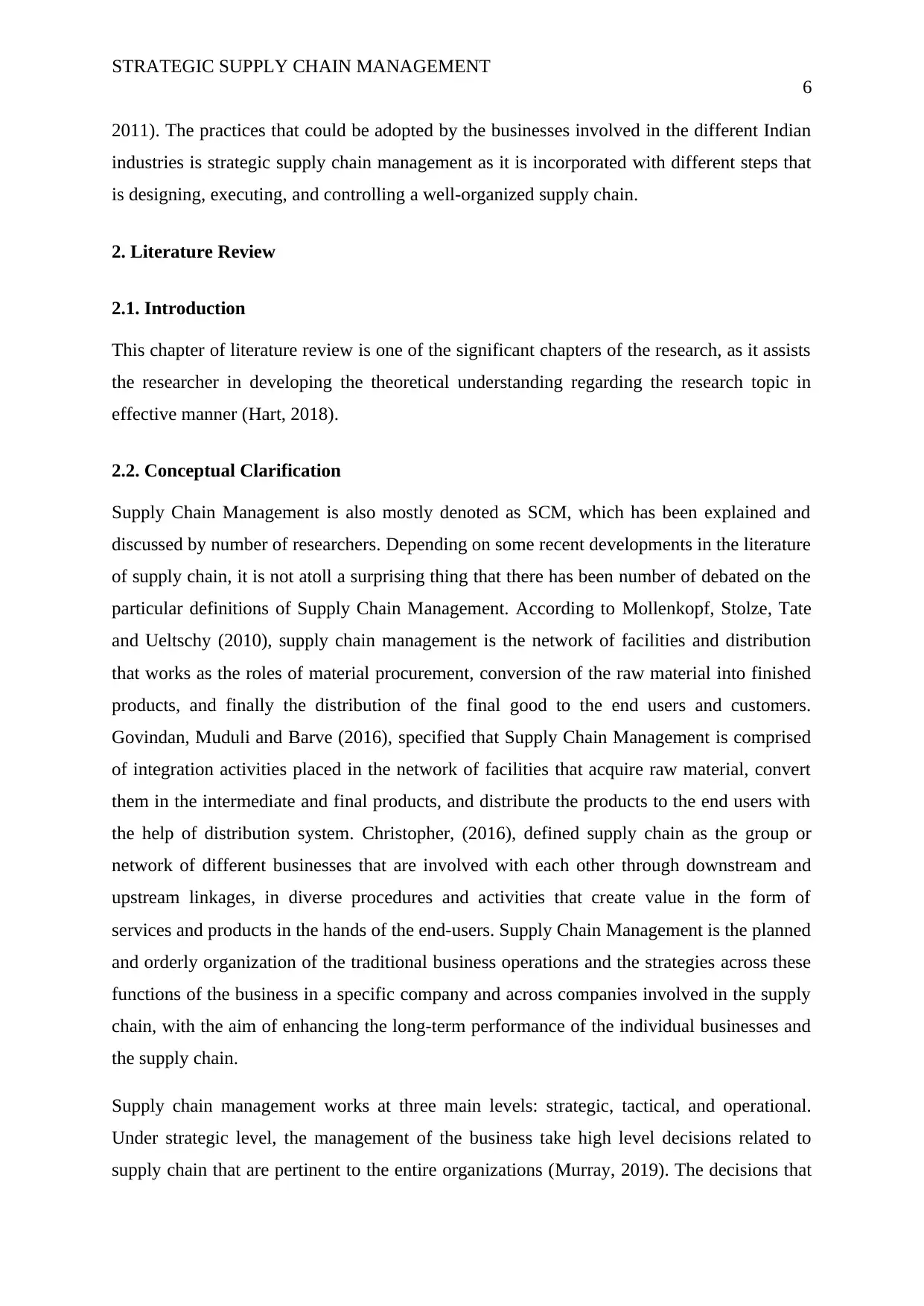
STRATEGIC SUPPLY CHAIN MANAGEMENT
6
2011). The practices that could be adopted by the businesses involved in the different Indian
industries is strategic supply chain management as it is incorporated with different steps that
is designing, executing, and controlling a well-organized supply chain.
2. Literature Review
2.1. Introduction
This chapter of literature review is one of the significant chapters of the research, as it assists
the researcher in developing the theoretical understanding regarding the research topic in
effective manner (Hart, 2018).
2.2. Conceptual Clarification
Supply Chain Management is also mostly denoted as SCM, which has been explained and
discussed by number of researchers. Depending on some recent developments in the literature
of supply chain, it is not atoll a surprising thing that there has been number of debated on the
particular definitions of Supply Chain Management. According to Mollenkopf, Stolze, Tate
and Ueltschy (2010), supply chain management is the network of facilities and distribution
that works as the roles of material procurement, conversion of the raw material into finished
products, and finally the distribution of the final good to the end users and customers.
Govindan, Muduli and Barve (2016), specified that Supply Chain Management is comprised
of integration activities placed in the network of facilities that acquire raw material, convert
them in the intermediate and final products, and distribute the products to the end users with
the help of distribution system. Christopher, (2016), defined supply chain as the group or
network of different businesses that are involved with each other through downstream and
upstream linkages, in diverse procedures and activities that create value in the form of
services and products in the hands of the end-users. Supply Chain Management is the planned
and orderly organization of the traditional business operations and the strategies across these
functions of the business in a specific company and across companies involved in the supply
chain, with the aim of enhancing the long-term performance of the individual businesses and
the supply chain.
Supply chain management works at three main levels: strategic, tactical, and operational.
Under strategic level, the management of the business take high level decisions related to
supply chain that are pertinent to the entire organizations (Murray, 2019). The decisions that
6
2011). The practices that could be adopted by the businesses involved in the different Indian
industries is strategic supply chain management as it is incorporated with different steps that
is designing, executing, and controlling a well-organized supply chain.
2. Literature Review
2.1. Introduction
This chapter of literature review is one of the significant chapters of the research, as it assists
the researcher in developing the theoretical understanding regarding the research topic in
effective manner (Hart, 2018).
2.2. Conceptual Clarification
Supply Chain Management is also mostly denoted as SCM, which has been explained and
discussed by number of researchers. Depending on some recent developments in the literature
of supply chain, it is not atoll a surprising thing that there has been number of debated on the
particular definitions of Supply Chain Management. According to Mollenkopf, Stolze, Tate
and Ueltschy (2010), supply chain management is the network of facilities and distribution
that works as the roles of material procurement, conversion of the raw material into finished
products, and finally the distribution of the final good to the end users and customers.
Govindan, Muduli and Barve (2016), specified that Supply Chain Management is comprised
of integration activities placed in the network of facilities that acquire raw material, convert
them in the intermediate and final products, and distribute the products to the end users with
the help of distribution system. Christopher, (2016), defined supply chain as the group or
network of different businesses that are involved with each other through downstream and
upstream linkages, in diverse procedures and activities that create value in the form of
services and products in the hands of the end-users. Supply Chain Management is the planned
and orderly organization of the traditional business operations and the strategies across these
functions of the business in a specific company and across companies involved in the supply
chain, with the aim of enhancing the long-term performance of the individual businesses and
the supply chain.
Supply chain management works at three main levels: strategic, tactical, and operational.
Under strategic level, the management of the business take high level decisions related to
supply chain that are pertinent to the entire organizations (Murray, 2019). The decisions that
Paraphrase This Document
Need a fresh take? Get an instant paraphrase of this document with our AI Paraphraser

STRATEGIC SUPPLY CHAIN MANAGEMENT
7
are considered related to the supply chain highlight the complete corporate strategy that a
company is complying with. The procedure of strategic supply chain that has been decided by
the management covers the extent of the supply chain. These comprise development of the
product, consumers, producers or manufacturers, vendors, and logistics.
According to Carter and Liane Easton (2011), the supply chain strategy is the set of needs of
the customers that the businesses seeks to gratify through its services and products. A
characteristic strategy of supply chain must target at attaining a smooth flow of goals at very
minimum prices. It is generally accepted that one size does not fit all, when it is regarding
designing the strategy of supply chain to support a broad variety of products with diverse
characteristics sold in different markets.
In the context of the manufacturing industries of India, the electricity industry has changed
majorly to offer a broad variety of opportunities in the value chain, in both, the structured and
derestricted companies. Indian electrical market is said to the fifth largest market of the world
in regards to the capacity of energy generation and the third largest in the context of network
(PWC, 2019). The increasing demand, up gradation, and network extension, decrease in the
intensity of the energy, unbundling of the services of supply and development of trade of
cross-border, open number of opportunities for this industry. Tough, there are various
challenges in the direction of this industry like supply of fuel, risk of country-party stood by
distribution businesses, restrictions of the monopoly on open access and the accessibility of
the finance for the project (Hellström and Nilsson, 2011).
Challenges for the Electrical Industries in India
Energy businesses are constantly rethinking their supply chains to increase the number of
opportunities, decrease cost and attain competitive advantage.
Complexity – The activities of the energy sector are planned to be operated in the remote
regions where the key challenge is of logistics in regards to physical infrastructure and
obedience with severe environmental, safety, and health protocols. In addition, sheer scale of
few of the operations and the requirement to source from the suppliers founded in the distant
reaches of the world; the grouping makes for mainly difficult operating circumstances and the
necessity to overcome disjointed cross-border supply chains (DHL, 2019).
7
are considered related to the supply chain highlight the complete corporate strategy that a
company is complying with. The procedure of strategic supply chain that has been decided by
the management covers the extent of the supply chain. These comprise development of the
product, consumers, producers or manufacturers, vendors, and logistics.
According to Carter and Liane Easton (2011), the supply chain strategy is the set of needs of
the customers that the businesses seeks to gratify through its services and products. A
characteristic strategy of supply chain must target at attaining a smooth flow of goals at very
minimum prices. It is generally accepted that one size does not fit all, when it is regarding
designing the strategy of supply chain to support a broad variety of products with diverse
characteristics sold in different markets.
In the context of the manufacturing industries of India, the electricity industry has changed
majorly to offer a broad variety of opportunities in the value chain, in both, the structured and
derestricted companies. Indian electrical market is said to the fifth largest market of the world
in regards to the capacity of energy generation and the third largest in the context of network
(PWC, 2019). The increasing demand, up gradation, and network extension, decrease in the
intensity of the energy, unbundling of the services of supply and development of trade of
cross-border, open number of opportunities for this industry. Tough, there are various
challenges in the direction of this industry like supply of fuel, risk of country-party stood by
distribution businesses, restrictions of the monopoly on open access and the accessibility of
the finance for the project (Hellström and Nilsson, 2011).
Challenges for the Electrical Industries in India
Energy businesses are constantly rethinking their supply chains to increase the number of
opportunities, decrease cost and attain competitive advantage.
Complexity – The activities of the energy sector are planned to be operated in the remote
regions where the key challenge is of logistics in regards to physical infrastructure and
obedience with severe environmental, safety, and health protocols. In addition, sheer scale of
few of the operations and the requirement to source from the suppliers founded in the distant
reaches of the world; the grouping makes for mainly difficult operating circumstances and the
necessity to overcome disjointed cross-border supply chains (DHL, 2019).
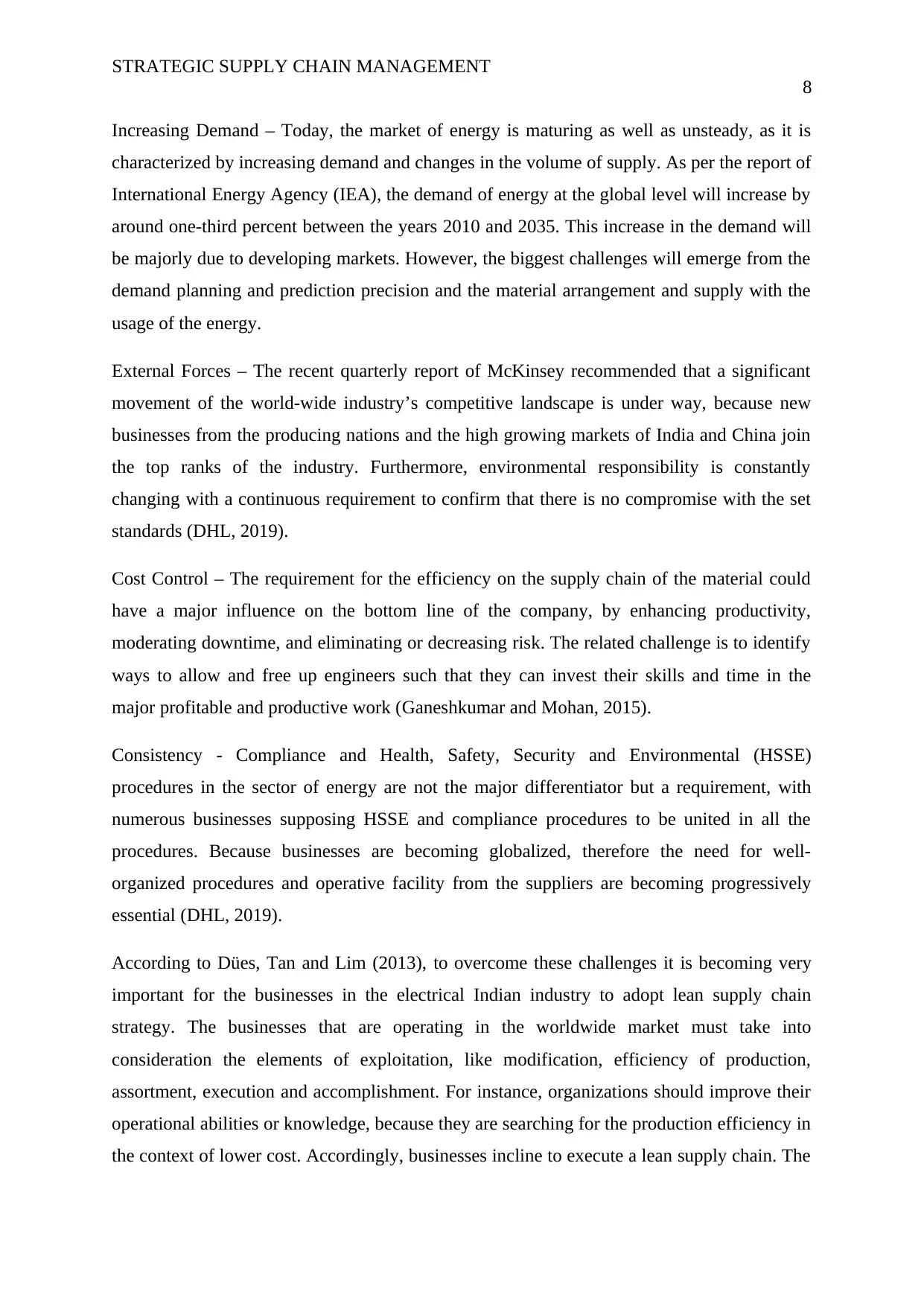
STRATEGIC SUPPLY CHAIN MANAGEMENT
8
Increasing Demand – Today, the market of energy is maturing as well as unsteady, as it is
characterized by increasing demand and changes in the volume of supply. As per the report of
International Energy Agency (IEA), the demand of energy at the global level will increase by
around one-third percent between the years 2010 and 2035. This increase in the demand will
be majorly due to developing markets. However, the biggest challenges will emerge from the
demand planning and prediction precision and the material arrangement and supply with the
usage of the energy.
External Forces – The recent quarterly report of McKinsey recommended that a significant
movement of the world-wide industry’s competitive landscape is under way, because new
businesses from the producing nations and the high growing markets of India and China join
the top ranks of the industry. Furthermore, environmental responsibility is constantly
changing with a continuous requirement to confirm that there is no compromise with the set
standards (DHL, 2019).
Cost Control – The requirement for the efficiency on the supply chain of the material could
have a major influence on the bottom line of the company, by enhancing productivity,
moderating downtime, and eliminating or decreasing risk. The related challenge is to identify
ways to allow and free up engineers such that they can invest their skills and time in the
major profitable and productive work (Ganeshkumar and Mohan, 2015).
Consistency - Compliance and Health, Safety, Security and Environmental (HSSE)
procedures in the sector of energy are not the major differentiator but a requirement, with
numerous businesses supposing HSSE and compliance procedures to be united in all the
procedures. Because businesses are becoming globalized, therefore the need for well-
organized procedures and operative facility from the suppliers are becoming progressively
essential (DHL, 2019).
According to Dües, Tan and Lim (2013), to overcome these challenges it is becoming very
important for the businesses in the electrical Indian industry to adopt lean supply chain
strategy. The businesses that are operating in the worldwide market must take into
consideration the elements of exploitation, like modification, efficiency of production,
assortment, execution and accomplishment. For instance, organizations should improve their
operational abilities or knowledge, because they are searching for the production efficiency in
the context of lower cost. Accordingly, businesses incline to execute a lean supply chain. The
8
Increasing Demand – Today, the market of energy is maturing as well as unsteady, as it is
characterized by increasing demand and changes in the volume of supply. As per the report of
International Energy Agency (IEA), the demand of energy at the global level will increase by
around one-third percent between the years 2010 and 2035. This increase in the demand will
be majorly due to developing markets. However, the biggest challenges will emerge from the
demand planning and prediction precision and the material arrangement and supply with the
usage of the energy.
External Forces – The recent quarterly report of McKinsey recommended that a significant
movement of the world-wide industry’s competitive landscape is under way, because new
businesses from the producing nations and the high growing markets of India and China join
the top ranks of the industry. Furthermore, environmental responsibility is constantly
changing with a continuous requirement to confirm that there is no compromise with the set
standards (DHL, 2019).
Cost Control – The requirement for the efficiency on the supply chain of the material could
have a major influence on the bottom line of the company, by enhancing productivity,
moderating downtime, and eliminating or decreasing risk. The related challenge is to identify
ways to allow and free up engineers such that they can invest their skills and time in the
major profitable and productive work (Ganeshkumar and Mohan, 2015).
Consistency - Compliance and Health, Safety, Security and Environmental (HSSE)
procedures in the sector of energy are not the major differentiator but a requirement, with
numerous businesses supposing HSSE and compliance procedures to be united in all the
procedures. Because businesses are becoming globalized, therefore the need for well-
organized procedures and operative facility from the suppliers are becoming progressively
essential (DHL, 2019).
According to Dües, Tan and Lim (2013), to overcome these challenges it is becoming very
important for the businesses in the electrical Indian industry to adopt lean supply chain
strategy. The businesses that are operating in the worldwide market must take into
consideration the elements of exploitation, like modification, efficiency of production,
assortment, execution and accomplishment. For instance, organizations should improve their
operational abilities or knowledge, because they are searching for the production efficiency in
the context of lower cost. Accordingly, businesses incline to execute a lean supply chain. The
⊘ This is a preview!⊘
Do you want full access?
Subscribe today to unlock all pages.

Trusted by 1+ million students worldwide
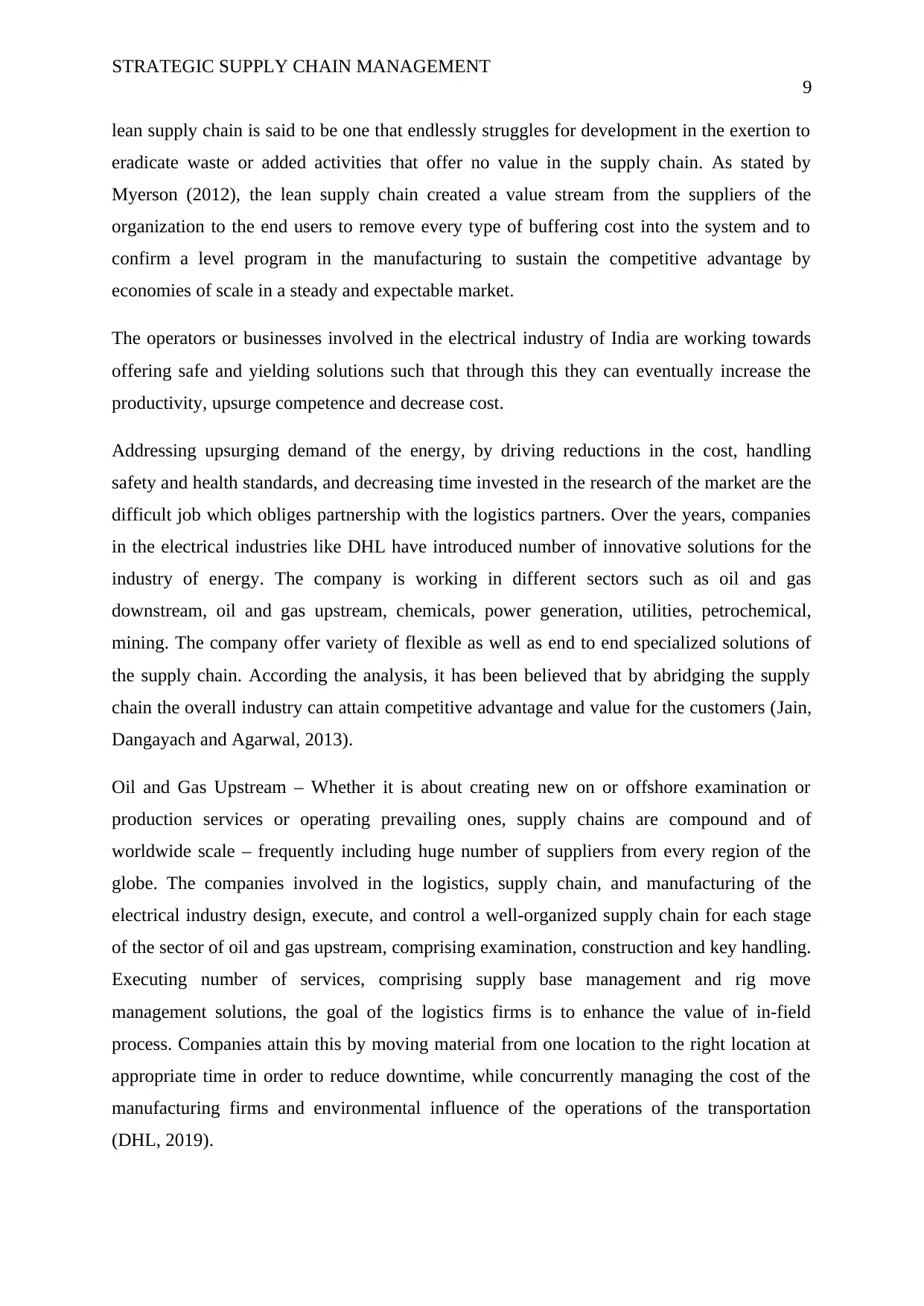
STRATEGIC SUPPLY CHAIN MANAGEMENT
9
lean supply chain is said to be one that endlessly struggles for development in the exertion to
eradicate waste or added activities that offer no value in the supply chain. As stated by
Myerson (2012), the lean supply chain created a value stream from the suppliers of the
organization to the end users to remove every type of buffering cost into the system and to
confirm a level program in the manufacturing to sustain the competitive advantage by
economies of scale in a steady and expectable market.
The operators or businesses involved in the electrical industry of India are working towards
offering safe and yielding solutions such that through this they can eventually increase the
productivity, upsurge competence and decrease cost.
Addressing upsurging demand of the energy, by driving reductions in the cost, handling
safety and health standards, and decreasing time invested in the research of the market are the
difficult job which obliges partnership with the logistics partners. Over the years, companies
in the electrical industries like DHL have introduced number of innovative solutions for the
industry of energy. The company is working in different sectors such as oil and gas
downstream, oil and gas upstream, chemicals, power generation, utilities, petrochemical,
mining. The company offer variety of flexible as well as end to end specialized solutions of
the supply chain. According the analysis, it has been believed that by abridging the supply
chain the overall industry can attain competitive advantage and value for the customers (Jain,
Dangayach and Agarwal, 2013).
Oil and Gas Upstream – Whether it is about creating new on or offshore examination or
production services or operating prevailing ones, supply chains are compound and of
worldwide scale – frequently including huge number of suppliers from every region of the
globe. The companies involved in the logistics, supply chain, and manufacturing of the
electrical industry design, execute, and control a well-organized supply chain for each stage
of the sector of oil and gas upstream, comprising examination, construction and key handling.
Executing number of services, comprising supply base management and rig move
management solutions, the goal of the logistics firms is to enhance the value of in-field
process. Companies attain this by moving material from one location to the right location at
appropriate time in order to reduce downtime, while concurrently managing the cost of the
manufacturing firms and environmental influence of the operations of the transportation
(DHL, 2019).
9
lean supply chain is said to be one that endlessly struggles for development in the exertion to
eradicate waste or added activities that offer no value in the supply chain. As stated by
Myerson (2012), the lean supply chain created a value stream from the suppliers of the
organization to the end users to remove every type of buffering cost into the system and to
confirm a level program in the manufacturing to sustain the competitive advantage by
economies of scale in a steady and expectable market.
The operators or businesses involved in the electrical industry of India are working towards
offering safe and yielding solutions such that through this they can eventually increase the
productivity, upsurge competence and decrease cost.
Addressing upsurging demand of the energy, by driving reductions in the cost, handling
safety and health standards, and decreasing time invested in the research of the market are the
difficult job which obliges partnership with the logistics partners. Over the years, companies
in the electrical industries like DHL have introduced number of innovative solutions for the
industry of energy. The company is working in different sectors such as oil and gas
downstream, oil and gas upstream, chemicals, power generation, utilities, petrochemical,
mining. The company offer variety of flexible as well as end to end specialized solutions of
the supply chain. According the analysis, it has been believed that by abridging the supply
chain the overall industry can attain competitive advantage and value for the customers (Jain,
Dangayach and Agarwal, 2013).
Oil and Gas Upstream – Whether it is about creating new on or offshore examination or
production services or operating prevailing ones, supply chains are compound and of
worldwide scale – frequently including huge number of suppliers from every region of the
globe. The companies involved in the logistics, supply chain, and manufacturing of the
electrical industry design, execute, and control a well-organized supply chain for each stage
of the sector of oil and gas upstream, comprising examination, construction and key handling.
Executing number of services, comprising supply base management and rig move
management solutions, the goal of the logistics firms is to enhance the value of in-field
process. Companies attain this by moving material from one location to the right location at
appropriate time in order to reduce downtime, while concurrently managing the cost of the
manufacturing firms and environmental influence of the operations of the transportation
(DHL, 2019).
Paraphrase This Document
Need a fresh take? Get an instant paraphrase of this document with our AI Paraphraser

STRATEGIC SUPPLY CHAIN MANAGEMENT
10
Power and Utilities – Companies like DHL help the businesses in creating projects and
supporting them in prevailing water infrastructure, gas, and electricity. This prolongs to
assisting businesses with alternative energy with a durable renewable set. The company is
very well aware of the strong renewable portfolio. DHL is conscious of all the challenges
accessible from the inappropriate infrastructures, to augmented governmental emphasis on
discovering substitute sources of energy. The company work to design, execute, and manage
the supply chain services that can improve the productivity of the business by decreasing
costs. The manufacturing firms in the electrical industry understand the dramatic impact of
more competent supply chain of indirect materials on their business by augmented use of
engineers, decreasing the risk and reducing downtime. This knowledge support the
manufacturing as well as logistics firms in increasing efficiency of the supply chain well,
maintaining vital equipment online, while releasing the engineers to invest their skills and
time in profitable and productive methods for the organization (DHL, 2019).
In addition to this, today the Indian manufacturing firms are emphasising on green supply
chain management. According to Srivastava (2007), GSCM is the single procedure that is
incorporating the environmental aspects and thinking in the supply chain management which
is generally comprised of designing of the product, sourcing and selection of material,
procedure of manufacturing, finished product delivery to the end customer and end-of-life
management of the product after the product’s useful life. Green Supply Chain Management
has its origins in the literature of environment and strategic supply chain management. As per
the previous research conducted on the supply chain management, reflects that investments in
the greening can reduce wastage, enhance productivity, and save lot of resources of the
industries involved in the exploitation of natural resources or other resources such as
electrical industry. The researchers suggest three approaches to be adopted in the execution of
green supply chain management are reactive, proactive, and value seeking (Simpson and
Sampson, 2008). India is a nation where concern in the context of green supply chain
management has become severe. The worldwide drift to source and manufacture products in
the nations offering opportunities at low cost is probable to cover the strength in next ten
years, mainly in the skill demanding industries like electrical, automotive industry, etc. where
India has attained major competitive advantage. As India is known as the key manufacturing
nation, it has number of opportunities, but they also experience considerable environmental
effects with this opportunity. The over-all Indian economy emission in the year 2003-2004 is
projected to be around carbon dioxide’s 217 million tons; from this over 57% is because of
10
Power and Utilities – Companies like DHL help the businesses in creating projects and
supporting them in prevailing water infrastructure, gas, and electricity. This prolongs to
assisting businesses with alternative energy with a durable renewable set. The company is
very well aware of the strong renewable portfolio. DHL is conscious of all the challenges
accessible from the inappropriate infrastructures, to augmented governmental emphasis on
discovering substitute sources of energy. The company work to design, execute, and manage
the supply chain services that can improve the productivity of the business by decreasing
costs. The manufacturing firms in the electrical industry understand the dramatic impact of
more competent supply chain of indirect materials on their business by augmented use of
engineers, decreasing the risk and reducing downtime. This knowledge support the
manufacturing as well as logistics firms in increasing efficiency of the supply chain well,
maintaining vital equipment online, while releasing the engineers to invest their skills and
time in profitable and productive methods for the organization (DHL, 2019).
In addition to this, today the Indian manufacturing firms are emphasising on green supply
chain management. According to Srivastava (2007), GSCM is the single procedure that is
incorporating the environmental aspects and thinking in the supply chain management which
is generally comprised of designing of the product, sourcing and selection of material,
procedure of manufacturing, finished product delivery to the end customer and end-of-life
management of the product after the product’s useful life. Green Supply Chain Management
has its origins in the literature of environment and strategic supply chain management. As per
the previous research conducted on the supply chain management, reflects that investments in
the greening can reduce wastage, enhance productivity, and save lot of resources of the
industries involved in the exploitation of natural resources or other resources such as
electrical industry. The researchers suggest three approaches to be adopted in the execution of
green supply chain management are reactive, proactive, and value seeking (Simpson and
Sampson, 2008). India is a nation where concern in the context of green supply chain
management has become severe. The worldwide drift to source and manufacture products in
the nations offering opportunities at low cost is probable to cover the strength in next ten
years, mainly in the skill demanding industries like electrical, automotive industry, etc. where
India has attained major competitive advantage. As India is known as the key manufacturing
nation, it has number of opportunities, but they also experience considerable environmental
effects with this opportunity. The over-all Indian economy emission in the year 2003-2004 is
projected to be around carbon dioxide’s 217 million tons; from this over 57% is because of
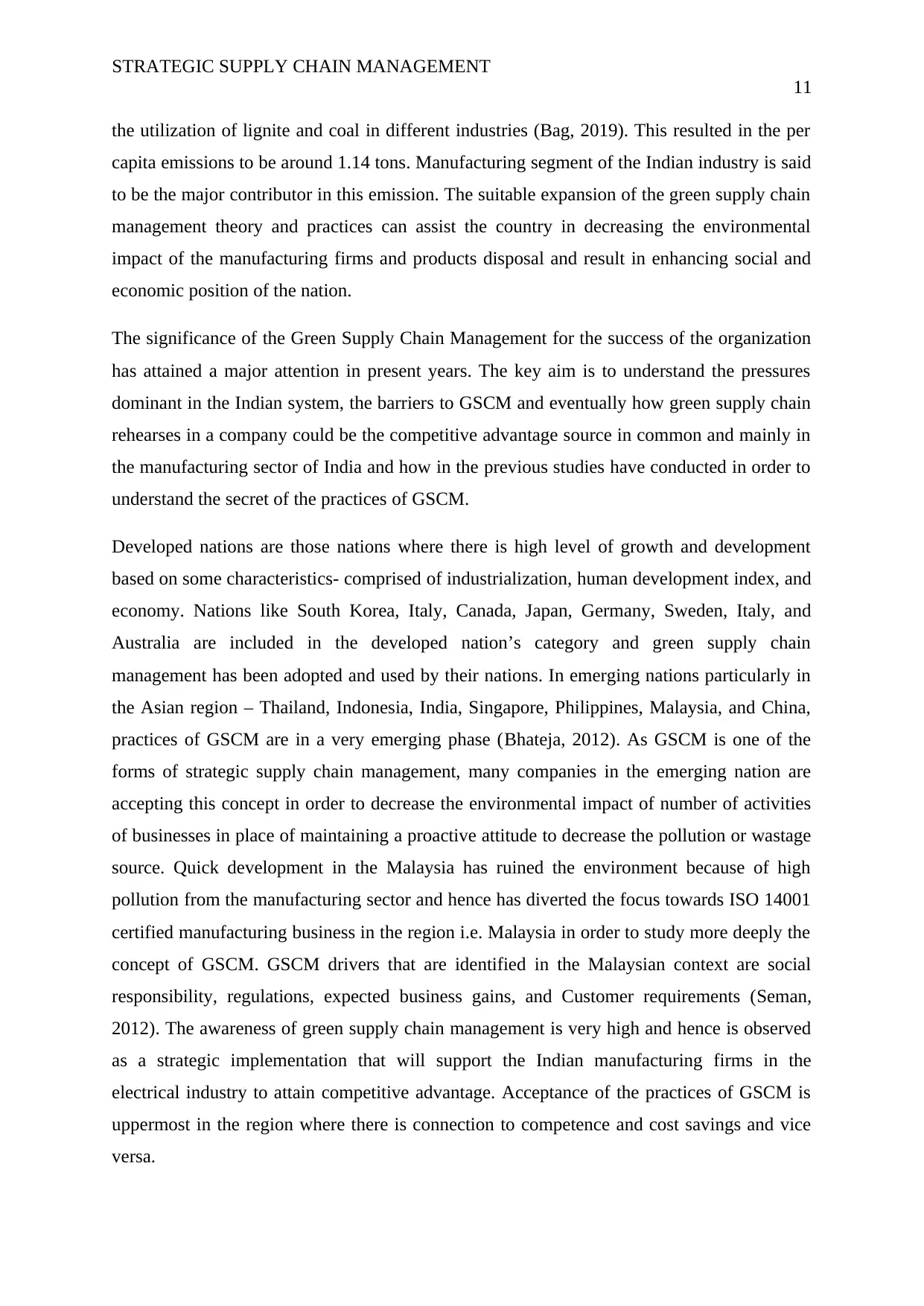
STRATEGIC SUPPLY CHAIN MANAGEMENT
11
the utilization of lignite and coal in different industries (Bag, 2019). This resulted in the per
capita emissions to be around 1.14 tons. Manufacturing segment of the Indian industry is said
to be the major contributor in this emission. The suitable expansion of the green supply chain
management theory and practices can assist the country in decreasing the environmental
impact of the manufacturing firms and products disposal and result in enhancing social and
economic position of the nation.
The significance of the Green Supply Chain Management for the success of the organization
has attained a major attention in present years. The key aim is to understand the pressures
dominant in the Indian system, the barriers to GSCM and eventually how green supply chain
rehearses in a company could be the competitive advantage source in common and mainly in
the manufacturing sector of India and how in the previous studies have conducted in order to
understand the secret of the practices of GSCM.
Developed nations are those nations where there is high level of growth and development
based on some characteristics- comprised of industrialization, human development index, and
economy. Nations like South Korea, Italy, Canada, Japan, Germany, Sweden, Italy, and
Australia are included in the developed nation’s category and green supply chain
management has been adopted and used by their nations. In emerging nations particularly in
the Asian region – Thailand, Indonesia, India, Singapore, Philippines, Malaysia, and China,
practices of GSCM are in a very emerging phase (Bhateja, 2012). As GSCM is one of the
forms of strategic supply chain management, many companies in the emerging nation are
accepting this concept in order to decrease the environmental impact of number of activities
of businesses in place of maintaining a proactive attitude to decrease the pollution or wastage
source. Quick development in the Malaysia has ruined the environment because of high
pollution from the manufacturing sector and hence has diverted the focus towards ISO 14001
certified manufacturing business in the region i.e. Malaysia in order to study more deeply the
concept of GSCM. GSCM drivers that are identified in the Malaysian context are social
responsibility, regulations, expected business gains, and Customer requirements (Seman,
2012). The awareness of green supply chain management is very high and hence is observed
as a strategic implementation that will support the Indian manufacturing firms in the
electrical industry to attain competitive advantage. Acceptance of the practices of GSCM is
uppermost in the region where there is connection to competence and cost savings and vice
versa.
11
the utilization of lignite and coal in different industries (Bag, 2019). This resulted in the per
capita emissions to be around 1.14 tons. Manufacturing segment of the Indian industry is said
to be the major contributor in this emission. The suitable expansion of the green supply chain
management theory and practices can assist the country in decreasing the environmental
impact of the manufacturing firms and products disposal and result in enhancing social and
economic position of the nation.
The significance of the Green Supply Chain Management for the success of the organization
has attained a major attention in present years. The key aim is to understand the pressures
dominant in the Indian system, the barriers to GSCM and eventually how green supply chain
rehearses in a company could be the competitive advantage source in common and mainly in
the manufacturing sector of India and how in the previous studies have conducted in order to
understand the secret of the practices of GSCM.
Developed nations are those nations where there is high level of growth and development
based on some characteristics- comprised of industrialization, human development index, and
economy. Nations like South Korea, Italy, Canada, Japan, Germany, Sweden, Italy, and
Australia are included in the developed nation’s category and green supply chain
management has been adopted and used by their nations. In emerging nations particularly in
the Asian region – Thailand, Indonesia, India, Singapore, Philippines, Malaysia, and China,
practices of GSCM are in a very emerging phase (Bhateja, 2012). As GSCM is one of the
forms of strategic supply chain management, many companies in the emerging nation are
accepting this concept in order to decrease the environmental impact of number of activities
of businesses in place of maintaining a proactive attitude to decrease the pollution or wastage
source. Quick development in the Malaysia has ruined the environment because of high
pollution from the manufacturing sector and hence has diverted the focus towards ISO 14001
certified manufacturing business in the region i.e. Malaysia in order to study more deeply the
concept of GSCM. GSCM drivers that are identified in the Malaysian context are social
responsibility, regulations, expected business gains, and Customer requirements (Seman,
2012). The awareness of green supply chain management is very high and hence is observed
as a strategic implementation that will support the Indian manufacturing firms in the
electrical industry to attain competitive advantage. Acceptance of the practices of GSCM is
uppermost in the region where there is connection to competence and cost savings and vice
versa.
⊘ This is a preview!⊘
Do you want full access?
Subscribe today to unlock all pages.

Trusted by 1+ million students worldwide
1 out of 42
Related Documents
Your All-in-One AI-Powered Toolkit for Academic Success.
+13062052269
info@desklib.com
Available 24*7 on WhatsApp / Email
![[object Object]](/_next/static/media/star-bottom.7253800d.svg)
Unlock your academic potential
Copyright © 2020–2025 A2Z Services. All Rights Reserved. Developed and managed by ZUCOL.




